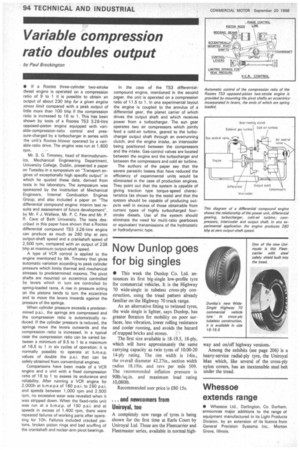Variable compression ratio doubles output
Page 98

If you've noticed an error in this article please click here to report it so we can fix it.
by Paul Brockington
• If a Rootes three-cylinder two-stroke diesel engine is operated on a compression ratio of 9 to 1 it is possible to obtain an output of about 230 bhp for a given engine stress limit compared with a peak output of little more than 100 bhp if the compression ratio is increased to 16 to 1. This has been shown by tests of a Rootes TS3 3.26-litre opposed-piston engine equipped with variable-compression-ratio control and pressure-charged by a turbocharger in series with the unit's Rootes blower operated by a variable-ratio drive. The engine was run at 1,600 rpm.
Mr. S. G. Timoney, head of thermodynamics, Mechanical Engineering Department, University College, Dublin, presented a paper on Tuesday in a symposium on "Transport engines of exceptionally high specific output" in which he quoted these data, derived from tests in his laboratory. The symposium was sponsored by the Institution of Mechanical Engineers, Internal Combustion Engines Group, and also included a paper on "The differential compound engine: interim test results and assessment of future development", by Mr. F J. Wallace, Mr. P. C. Few and Mr. P. R. Cave of Bath University. The tests described in this paper have shown that a Rootes differential compound TS3 3.26-litre engine can produce as much as 260 bhp at zero output-shaft speed and a crankshaft speed of 2,500 rpm, compared with an output of 238 bhp at maximum output-shaft speed.
A type of VCR control is applied to the engine mentioned by Mr. Timoney that gives automatic variation according to peak cylinder pressure which limits thermal and mechanical stresses to predetermined maxima. The pivot shafts are mounted on eccentrics controlled by levers which in turn are controlled by spring-loaded rams. A rise in pressure acting on the pistons tends to turn the eccentrics and to move the levers inwards against the pressure of the springs.
When cylinder pressure exceeds a predetermined p.s.i., the springs are compressed and the compression ratio is automatically reduced. If the cylinder pressure is reduced, the springs move the levers outwards and the compression ratio is increased. In a typical case the compression ratio can be varied between a minimum of 9.5 to 1 to a maximum of 16.5 to 1 in six cycles of operation: it is normally possible to operate at b.m.e.p. values of double the p.s.i. that can be safely obtained from conventional engines.
Comparisons have been made of a VCR engine and a unit with a fixed compression ratio of 16 to 1 to assess its endurance and reliability. After running a VCR engine for 2,000h at b.m.e.p.s of 160 p.s.i. to 250 p.s.i. and speeds between 1,000 rpm and 2,500 rpm, no excessive wear was revealed when it was stripped down. When the fixed-ratio unit was run at a b.m.e.p. of 150 p.s.i. and at speeds in excess of 1,400 rpm, there were repeated failures of working parts after operating for 10h. Failures included cracked pistons, broken piston rings and bad scuffing of the crankshaft and rocker-arm pivot bearings. In the case of the TS3 differentialcompound engine, mentioned in the second paper, the unit is operated on a compression ratio of 11.5 to 1. In one experimental layout the engine is coupled to the annulus of a differential gear, the planet carrier of which drives the output shaft and which receives power from a turbocharger. The sun gear operates two air compressors which jointly feed a cold-air turbine, geared to the turbocharger output shaft through an overrunning clutch, and the engine intake, an intercooler being positioned between the compressors and the intake. Gas-control valves are located between the engine and the turbocharger and between the compressors and cold air turbine.
The authors of the paper say that the severe parasitic losses, that have reduced the efficiency of experimental units would be eliminated in the case of production engines. They point out that the system is capable of giving traction type torque-speed characteristics (as shown by the tests) and that the system should be capable of producing outputs well in excess of those obtainable from current types of highly turbocharged fourstroke diesels. Use of the system should eliminate the need for multi-ratio gearboxes or equivalent transmissions of the hydrostatic or hydrodynamic type.


















































































































































































































































































































































































